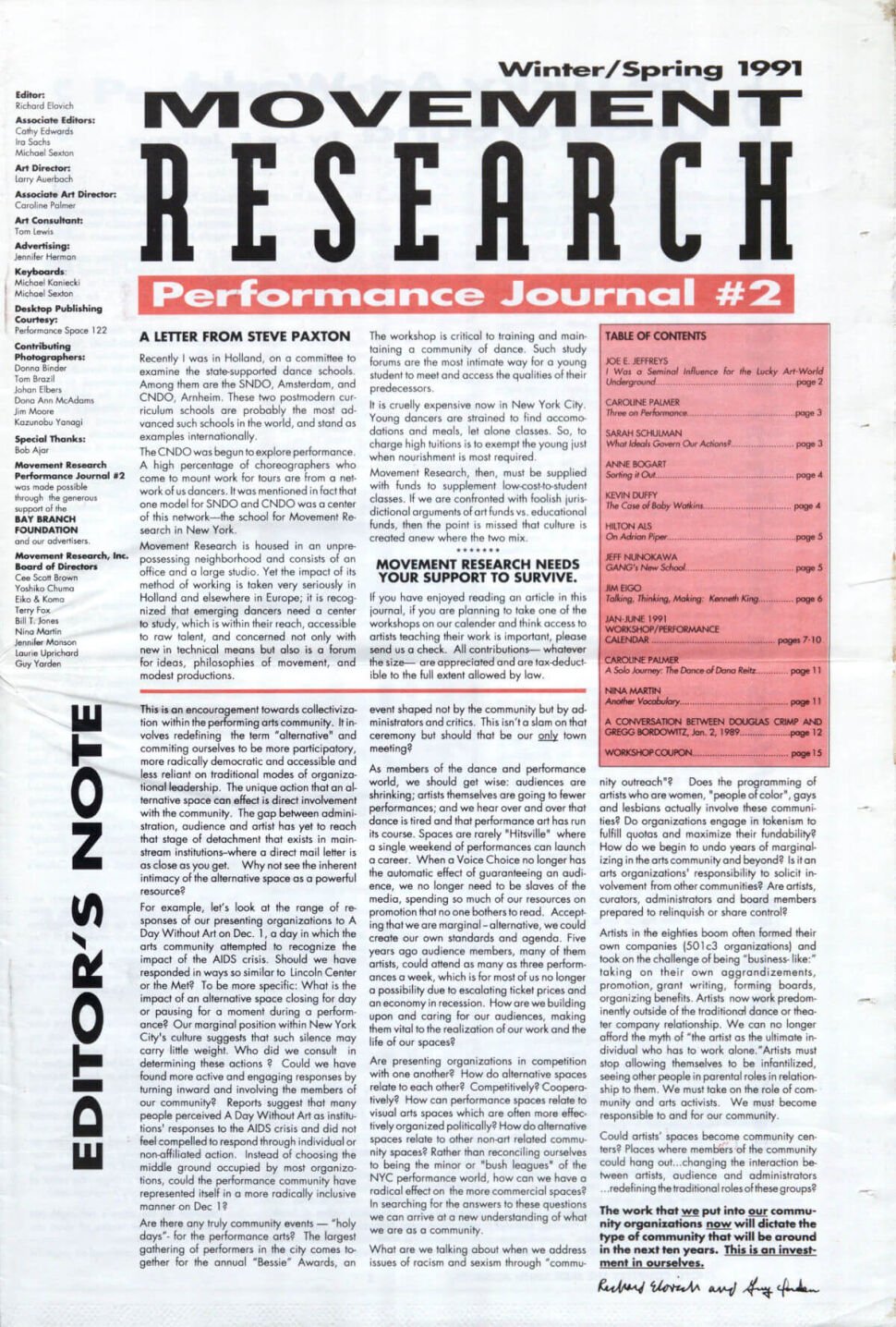Issue #02
Winter/Spring 1991

This is an encouragement towards collectivization within the performing arts community. It involves redefining the term "alternative" and committing ourselves to be more participatory, more radically democratic and accessible and less reliant on traditional modes of organizational leadership. The unique action that an alternative space can effect is direct involvement with the community. The gap between administration, audience and artist has yet to reach that stage of detachment that exists in mainstream institutions-where a direct mail letter is as close as you get. Why not see the inherent intimacy of the alternative space as a powerful resource?
For example, let's look at the range of responses of our presenting organizations to A Day Without Art on Dec. 1, a day in which the arts community attempted to recognize the impact of the AIDS crisis. Should we have responded in ways so similar to Lincoln Center or the Met? To be more specific: What is the impact of an alternative space closing for the day or pausing for a moment during a performance? Our marginal position within New York City's culture suggests that such silence may carry little weight. Who did we consult in determining these actions ? Could we have found more active and engaging responses by turning inward and involving the members of our community? Reports suggest that many people perceived A Day Without Art as institutions' responses to the AIDS crisis and did not feel compelled to respond through individual or non-affiliated action. Instead of choosing the middle ground occupied by most organizations, could the performance community have represented itself in a more radically inclusive manner on Dec 1?
Are there any truly community events — "holy days"- for the performance arts? The largest gathering of performers in the city comes together for the annual "Bessie" Awards, an event shaped not by the community but by administrators and critics. This isn't a slam on that ceremony but should that be our only town meeting?
[Excerpt from Editor’s Note by Richard Elovich and Guy Yarden]
Editorial team
Editor-In-Chief
Richard Elovich
Contributing Editor
Cathy Edwards - Ira Sachs - Michael Sexton
Design
Larry Auerbach - Tom Lewis
Ad Layout
Jennifer Herman
Articles
A Letter From Steve Paxton
Recently I was in Holland, on a committee to examine the state-supported dance schools. Among them are the SNDO, Amsterdam, and CNDO, Arnheim. These two postmodern curriculum schools are probably...
Editor’s Note
This is an encouragement towards collectivization within the performing arts community. It involves redefining the term "alternative" and committing ourselves to be more participatory, more radically democratic and accessible and...
Jack Smith: I was a Seminal Influence for the Lucky Art-World Underground
This article profiles experimental filmmaker Jack Smith, exploring his impact on underground film and performance art. Jeffreys examines the production history of Flaming Creatures, Smith's most well-known film.
Three on Performance
Palmer interviews performance artists Jo Andres, Ellen Fisher, and Tom Murrin about their careers, influences, and the future of performance art. Andres, Fisher, and Murrin find inspiration from a wide...
What Ideals Guide Our Actions?
Schulman argues that the arts community needs to establish a more democratic and anti-racist system for awarding grants. She proposes that grant panels be composed entirely of artists, with term...
Sorting It Out
Bogart discusses the impoverished use of the theatrical stage. She argues that the American theater prioritizes empathy over the possibilities of spectacle, political discourse, entertainment, ritual, and participation.
The Case of Baby Watkins
Duffy recounts his experience observing choreographer Tamar Rogoff work with clients of Project Moving On, a program for people with HIV/AIDS. The piece under development features scenes structured around games.
On Adrian Piper
Als reflects on Piper's use of photography and consciousness in her conceptual art. Als finds Piper's work to be courageous, philosophical, and challenging.
Gang’s New School
Nunokawa reviews a performance by GANG, a lesbian and gay activist art collective, at the 1990 Conference on Gay and Lesbian Studies at Harvard University. The performance was a response...
Talking Thinking making: Kenneth King (talKING thinKING...)
Eigo compares King's work to that of Douglas Dunn. While both are associated with postmodern dance, King's work prioritizes text, philosophy, and articulation, while Dunn is known for movement.
A Solo Journey: The Dance of Dana Reitz
This article profiles solo dancer and choreographer Dana Reitz. Palmer discusses Reitz's commitment to developing "stream of consciousness moving" and her study of the inner musicality of dance.
Another Vocabulary
Martin explores the challenges and rewards of improvisation. She argues that while shared vocabulary can be seen as the folk element in dance, dancers and choreographers create unique texture using...
A Conversation Between Douglas Crimp and Gregg Bordowitz
Crimp and Bordowitz discuss the function and transformation of art practices in relation to the AIDS crisis. They consider the role of institutional critique in art about AIDS and the...